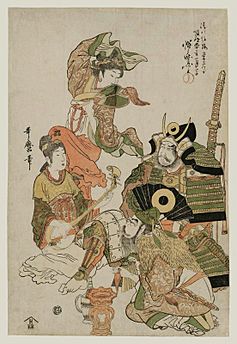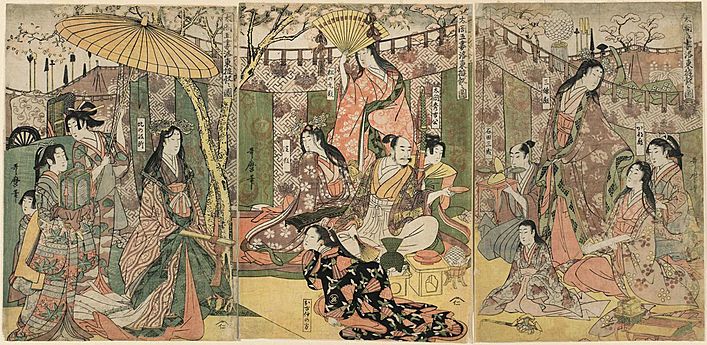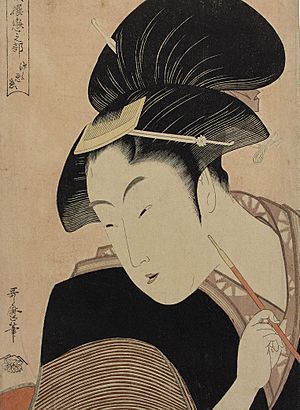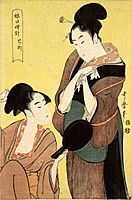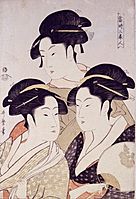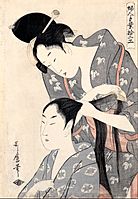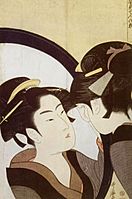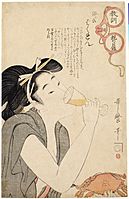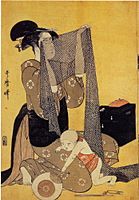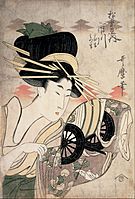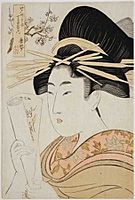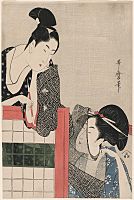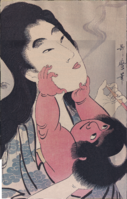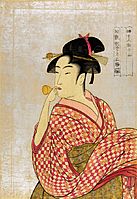Utamaro facts for kids
Quick facts for kids
Kitagawa Utamaro
|
|
|---|---|
| 喜多川 歌麿 | |
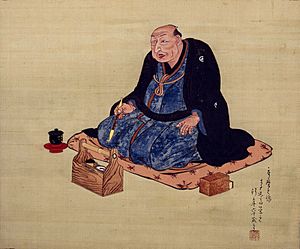
Portrait by Eishi, 1815
|
|
| Born |
Kitagawa Ichitarō
c. 1753 |
| Died | 31 October 1806 (aged 52–53) |
| Resting place | Senkōji |
| Style | Ukiyo-e |
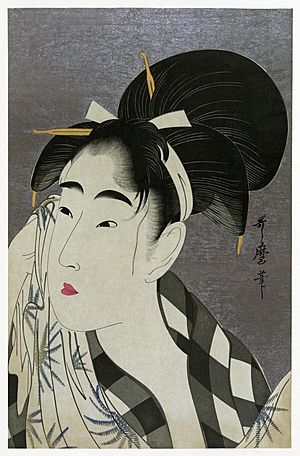
Kitagawa Utamaro (Japanese: 喜多川 歌麿; c. 1753 – 31 October 1806) was a famous Japanese artist. He was one of the best designers of ukiyo-e woodblock prints and paintings. He is most known for his bijin ōkubi-e prints from the 1790s. These were "large-headed pictures of beautiful women." He also made art about nature, especially illustrated books about insects.
We don't know much about Utamaro's early life. His artwork started appearing in the 1770s. He became very popular in the early 1790s. This was thanks to his portraits of beautiful women with long, graceful features. He created over 2000 known prints. He was one of the few ukiyo-e artists to become famous across Japan during his lifetime. In 1804, he faced trouble with the government for making prints about a historical military leader. He passed away two years later.
Utamaro's art arrived in Europe in the mid-1800s. It became very popular there, especially in France. He influenced European Impressionist artists. They liked his way of showing partial views and how he used light and shadow. When people talk about "Japanese influence" on these artists, they often mean Utamaro's work.
Contents
What is Ukiyo-e Art?
Ukiyo-e art was very popular in Japan. This was during the Edo period, from the 1600s to the 1800s. This art style often showed kabuki actors and scenes from everyday life. It focused on the "floating world" lifestyle of entertainment areas.
Besides paintings, many woodblock prints were made. These were a big part of the ukiyo-e style. Ukiyo-e art was made for regular townspeople. They lived in Edo, which is now Tokyo. Because it was for common people and mass-produced, it wasn't seen as "serious art" at the time.
In the mid-1700s, full-color prints called nishiki-e became common. These were made using many woodblocks, one for each color. Towards the end of the 1700s, ukiyo-e art reached its best quality and quantity. Torii Kiyonaga was a leading artist for portraits of beautiful women in the 1780s. His tall, graceful women greatly influenced Utamaro.
Katsukawa Shunshō introduced the ōkubi-e or "large-headed picture" in the 1760s. He and other artists made this style popular for actor prints. They also added sparkling mica dust to the backgrounds.
Utamaro's Life Story

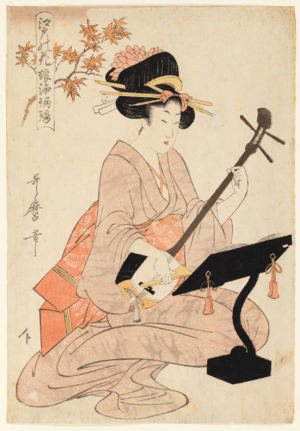
Early Life and Training
Not much is known about Utamaro's early life. He was born Kitagawa Ichitarō in about 1753. As an adult, he was also known as Yūsuke and later Yūki. People have suggested he was born in Kyoto, Osaka, or Edo. But none of these places have been proven. We don't know his parents' names. Some think his father might have owned a teahouse. Others believe his teacher, Toriyama Sekien, was his father. Sekien wrote about Utamaro playing in his garden as a child.
Utamaro seems to have married, but we know little about his wife. There are no records of them having children. However, many of his prints show sweet family scenes. They feature the same woman and child over several years.
During his childhood, Utamaro studied with Sekien. Sekien said his student was smart and loved art. Sekien was trained in a high-class painting style. But he later became an ukiyo-e artist, creating art for the townspeople in Edo.
First Works and New Name
Utamaro's first known work might be an illustration of eggplants. It was in a poetry book published in 1770. His next works appeared in 1775. He used the name Kitagawa Toyoaki then. These included the cover for a kabuki play book. As Toyoaki, he continued to illustrate popular books. He also sometimes made single prints of kabuki actors.
A young publisher named Tsutaya Jūzaburō hired Utamaro. In 1782, Utamaro hosted a big party. Many famous artists and writers attended. It's believed that at this party, he announced his new art name: Utamaro. He gave out a special print for the event. It showed him bowing deeply in front of a screen with his guests' names.
Around 1783, he likely moved in with Tsutaya Jūzaburō. He lived there for about five years. He became a main artist for Tsutaya's company. For a few years, he mostly illustrated books of kyōka (funny poems). We don't have any of his works from 1790 to 1792.
Becoming Famous
Around 1791, Utamaro stopped designing prints for books. He focused on making single portraits of women. These showed women from the waist up. Other ukiyo-e artists often showed women in groups.
In 1793, he became a recognized artist. His special agreement with Tsutaya Jūzaburō ended. Utamaro then created many famous series of works. All of them featured women from the Yoshiwara district.
Over the years, he also made many books about animals, insects, and nature.
Later Years and Challenges
Tsutaya Jūzaburō passed away in 1797. Utamaro was very sad to lose his friend and supporter. Some people believe his art was not as good after this event.
In 1790, a law was made that prints needed a censor's approval to be sold. Censorship became stricter over time. Artists who broke the rules could be punished. By 1799, even early sketches needed approval. In 1804, Utamaro faced legal trouble. This was for a series of prints showing samurai warriors. Showing warriors by name or with their family symbols was forbidden.
Trouble with the Government in 1804
A book called Ehon Taikōki was published from 1797 to 1802. It told the story of the 16th-century military leader, Toyotomi Hideyoshi. This story was very popular and used in plays. When artists made prints and books based on it in the ukiyo-e style, the government reacted.
In 1804, Utamaro was held for fifty days. Other artists also faced similar punishment. Their publishers had to pay large fines. Utamaro seemed to be the most well-known artist in this group. The artists might have upset the authorities by clearly showing historical figures with their names and symbols, which was against the rules.
- Utamaro prints that caused trouble in 1804
-
Katō Kiyomasa at a party with Korean dancers
His Passing
Records show Utamaro passed away on October 31, 1806. He was given a Buddhist name after his death. He had no known children, so his grave was left uncared for. About a hundred years later, in 1917, fans of Utamaro had his grave fixed.
Utamaro's Students
Utamaro had several students. They took names like Kikumaro (later Tsukimaro), Hidemaro, and Takemaro. These artists made works in Utamaro's style. However, none are thought to be as good as his. Sometimes, he let them sign his name. One of his students, Koikawa Shunchō, married Utamaro's widow after the master's death. He then took the name Utamaro II. After 1820, he used the name Kitagawa Tetsugorō for his art.
Utamaro's Lasting Influence
Utamaro was seen as a master during his own time. He became famous across Japan. This was unusual, as most popular Edo ukiyo-e artists were only known in their city. Because he was so popular, many artists copied Utamaro's style. Some even signed their work with his name. This likely included his students and his successor, Utamaro II. Sometimes, Utamaro signed his work "the genuine Utamaro" to show it was truly his. Copies and reprints of Utamaro's work are common. He made a lot of art, but his older, more popular works are hard to find in good condition.
In the mid-1800s, there was a big interest in Japanese art in France. This was called Japonism. Exhibitions of Japanese art began in Paris in the 1880s. These included an Utamaro exhibition in 1888. French Impressionist artists thought Utamaro's work was as important as that of Hokusai and Hiroshige. Famous French artists who collected Utamaro's work included Claude Monet, Edgar Degas, Paul Gauguin, and Henri de Toulouse-Lautrec.
Utamaro also influenced the American painter Mary Cassatt. His work affected her compositions, colors, and sense of calm. The shin-hanga ("new prints") artist Goyō Hashiguchi (1880–1921) was called the "Utamaro of the Taishō period" (1912–1926). This was because of how he drew women.
In 2016, Utamaro's Fukaku Shinobu Koi set a record price for an ukiyo-e print sold at auction. It sold for €745,000.
About Utamaro's History
The only official record of Utamaro is a stone marker at Senkō-ji Temple. It says he died on October 31, 1806. It also states he was 54 years old by Japanese counting. From this, we figure he was born around 1753.
Utamaro is now widely accepted as one of the greatest ukiyo-e masters. The first book about ukiyo-e artists was written when Utamaro was still alive. It was not printed, but many copies were made and changed by different writers. The oldest copy talks about Utamaro:
- Kitagawa Utamaro, real name Yūsuke.
- First joined the studio of Toriyama Sekien and learned painting. Later drew pictures of men and women's styles. Briefly lived with publisher Tsutaya Jūzaburō. Now lives near Benkei Bridge. Made many nishiki-e (full-color prints).
Early art critics from the West sometimes didn't see Utamaro as a top ukiyo-e artist. For example, Ernest Fenollosa in 1896 thought ukiyo-e art got worse after Utamaro. He didn't like Utamaro's "long figures" and "strong emotions." He liked Utamaro's students even less.
However, other experts disagreed. Laurence Binyon, from the British Museum, called Utamaro "one of the world's artists" and "the greatest of all the figure-designers" in ukiyo-e. He praised Utamaro's "endless" new ideas. James A. Michener later said the 1790s were the "culminating years of ukiyo-e," with Utamaro bringing grace to its highest point.
The French art critic Edmond de Goncourt wrote the first book just about Utamaro in 1891. British ukiyo-e expert Jack Hillier also wrote a book about Utamaro's prints and paintings in 1961.
Famous Print Series by Utamaro
Here are some of his well-known print series and when they were made:
- Utamakura (1788) - attributed
- Chosen Poems (1791–1792)
- Ten Types of Women's Physiognomies (1792–1793)
- Famous Beauties of Edo (1792–1793)
- Ten Learned Studies of Women (1792–1793)
- Anthology of Poems: The Love Section (1793–1794)
- Snow, Moon, and Flowers of the Green Houses (1793–1795)
- Five Shades of Ink in the Northern Quarter (1794–1795)
- Array of Supreme Beauties of the Present Day (1794)
- Twelve Hours of the Green Houses (1794–1795)
- Renowned Beauties from the Six Best Houses (1795–96)
- Flourishing Beauties of the Present Day (1795–1797)
- An Array of Passionate Lovers (1797–1798)
- Ten Forms of Feminine Physiognomy (1802)
Paintings
- Shinagawa no Tsuki, Yoshiwara no Hana, and Fukagawa no Yuki
Gallery
See also
 In Spanish: Utamaro para niños
In Spanish: Utamaro para niños



